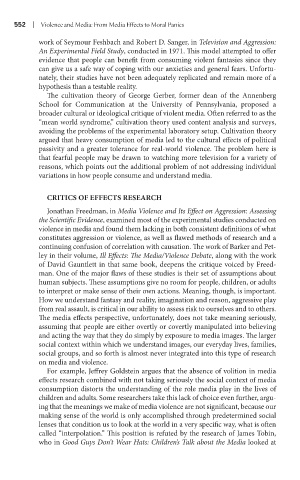Page 573 - Battleground The Media Volume 1 and 2
P. 573
| V olence and Med a: From Med a Effects to Moral Pan cs
work of Seymour Feshbach and Robert D. Sanger, in Television and Aggression:
An Experimental Field Study, conducted in 1971. This model attempted to offer
evidence that people can benefit from consuming violent fantasies since they
can give us a safe way of coping with our anxieties and general fears. Unfortu-
nately, their studies have not been adequately replicated and remain more of a
hypothesis than a testable reality.
The cultivation theory of George Gerber, former dean of the Annenberg
School for Communication at the University of Pennsylvania, proposed a
broader cultural or ideological critique of violent media. Often referred to as the
“mean world syndrome,” cultivation theory used content analysis and surveys,
avoiding the problems of the experimental laboratory setup. Cultivation theory
argued that heavy consumption of media led to the cultural effects of political
passivity and a greater tolerance for real-world violence. The problem here is
that fearful people may be drawn to watching more television for a variety of
reasons, which points out the additional problem of not addressing individual
variations in how people consume and understand media.
CriTiCs oF EFFECTs rEsEarCh
Jonathan Freedman, in Media Violence and Its Effect on Aggression: Assessing
the Scientific Evidence, examined most of the experimental studies conducted on
violence in media and found them lacking in both consistent definitions of what
constitutes aggression or violence, as well as flawed methods of research and a
continuing confusion of correlation with causation. The work of Barker and Pet-
ley in their volume, Ill Effects: The Media/Violence Debate, along with the work
of David Gauntlett in that same book, deepens the critique voiced by Freed-
man. One of the major flaws of these studies is their set of assumptions about
human subjects. These assumptions give no room for people, children, or adults
to interpret or make sense of their own actions. Meaning, though, is important.
How we understand fantasy and reality, imagination and reason, aggressive play
from real assault, is critical in our ability to assess risk to ourselves and to others.
The media effects perspective, unfortunately, does not take meaning seriously,
assuming that people are either overtly or covertly manipulated into believing
and acting the way that they do simply by exposure to media images. The larger
social context within which we understand images, our everyday lives, families,
social groups, and so forth is almost never integrated into this type of research
on media and violence.
For example, Jeffrey Goldstein argues that the absence of volition in media
effects research combined with not taking seriously the social context of media
consumption distorts the understanding of the role media play in the lives of
children and adults. Some researchers take this lack of choice even further, argu-
ing that the meanings we make of media violence are not significant, because our
making sense of the world is only accomplished through predetermined social
lenses that condition us to look at the world in a very specific way, what is often
called “interpolation.” This position is refuted by the research of James Tobin,
who in Good Guys Don’t Wear Hats: Children’s Talk about the Media looked at

